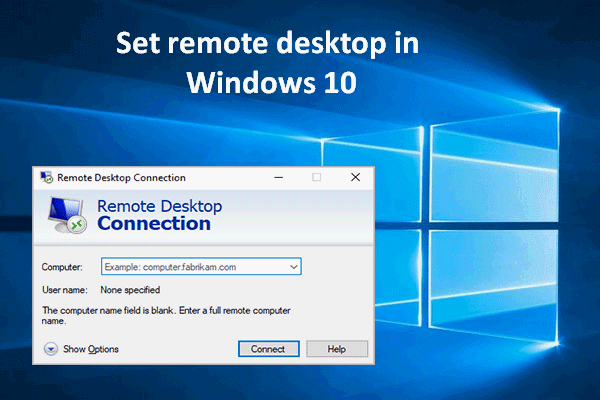What Is RDP (Remote Desktop Protocol) and How Does It Work [MiniTool Wiki]
What Is RDP?
Definition
What is an RDP? Remote Desktop Protocol (RDP) is a secure network communication protocol designed for remote management and remote access to virtual desktops, applications, and RDP terminal servers.
RDP allows network administrators to remotely diagnose and resolve problems encountered by individual subscribers. RDP supports most Windows operating systems and Apple macOS. Now, you can continue to read this post from MiniTool to get more information about the remote desktop protocol.
Features
The features of the remote desktop protocol are as follows:
- Encryption
- Smart
- Authentication
- Bandwidth reduction
- Resource sharing
Function
Do you know the functions of the remote desktop protocol? It can use multiple displays and can disconnect temporarily without logging off. It also allows redirection functions such as audio and printing.
RDP can support up to 64,000 independent channels for data transmission. The 128-bit key can be used to encrypt data, and the data transmission rate can be optimized in low-speed connections by the bandwidth reduction function.
How Does RDP Work?
After knowing “what is RDP”, let’s see “how does RDP work”. The RDP protocol is designed to provide remote access through port 3389. An RDP-enabled application or service packages the data to be transmitted and Microsoft Communications Service directs the data to the RDP channel. From there, the RDP data is encrypted by the operating system and it is added to the frame so that it can be transmitted.
The RDP protocol activity is handled by the Terminal Server Device Redirector Driver. The driver consists of subcomponents such as the RDP driver (Wdtshare.sys), which handles the encryption, compression, user interface, transmission, and framing. The transport driver (Tdtcp.sys) is responsible for packaging the protocol so that it can be sent over the TCP/IP network.
Tips for Establishing Secure Windows Remote Desktop Connections
Any kind of remote desktop solution brings potential vulnerabilities including the remote desktop protocol. RDP port periodically scans for exploits. If you plan to use Windows Remote Desktop via the Internet, you need to adopt appropriate strategies to protect it. The following are some tips for you:
- Limit password attempts.
- Use complex, secure passwords.
- Set RDP for maximum encryption.
- Don’t allow open RDP connections over the internet.
- Enable Network Level Authentication (NLA).
- Restrict RDP connections to non-administrators.
Also see: Microsoft Hyper-V Inherits the Reverse RDP Attack Security Flaws
How to Connect to a Remote Desktop on Windows
Now, let’s see how to connect to a Remote Desktop on Windows. Besides, maybe you are interested in this post - 6 Methods to Fix the Windows 10 Remote Desktop Not Working Error.
Step 1: Press the Windows key + R key at the same time to open the Run dialogue box. Then, type mstsc and press OK to launch the Remote Desktop Connection tool.
Step 2: Type the IP address or hostname of your Windows Remote Desktop in the Computer text box, then press Show Options.
Step 3: Type the username that you want to use to connect to your Windows Remote Desktop in the User name box.
Step 4: Under the Display tab, you need to confirm the display resolution and color quality of the remote connection.
Step 5: Windows will automatically try to determine your remote connection’s quality. If you want to set this manually, you can choose your connection speed under the Experience tab.
Step 6: Then, you will be asked to use a Remote Desktop Gateway to allow for a tunneled RDP connection to a secure network. You can click Advanced > Settings to set it
Step 7: Once you’re ready to make the connection, you need to click Connect. You may need to click Yes to confirm the warning message about the identity of the connection.
Final Words
What is RDP? This post has gathered the remote desktop protocol’s definition, features as function. Besides, you can know how it works and how to connect a remote desktop on Windows. If you want to learn some information about it, you can refer to this post.
